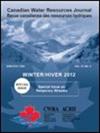Structural calibration of an semi-distributed hydrological model of the Liard River basin
IF 0.9
4区 环境科学与生态学
Q3 WATER RESOURCES
引用次数: 6
Abstract
Abstract The development of hydrological models that produce practically useful and physically defensible results is an ongoing challenge in hydrology. This challenge is further compounded in large, spatially variable basins with sparse data, where a detailed understanding of a basin’s hydrological response may be limited. This study presents an iterative and stepwise calibration strategy for model structure and parameters for a hydrological model of the 275,000 km2 Liard River basin in northern Canada. The calibration procedure was optimized to exploit and represent available data at 29 stream gauges and included the use of multiple data sources to constrain model calibration and improve model function. A flexible modelling framework was used to allow the explicit inclusion of locally varied model structure within the calibration procedure. The final model exhibits strong performance in both calibration and validation, and represents significantly different hydrological responses in different portions of the basin well. The calibration procedure helped to identify differences in hydrological processes within the basin which have not been considered by other models of the Liard. The ability to modify model structure in order to account for different hydrological regimes in different parts of the basin is demonstrated to improve model performance locally and globally.利亚德河流域半分布式水文模型的结构定标
水文模型的发展,产生实际有用的和物理上可辩护的结果是一个持续的挑战在水文学。在数据稀疏、空间多变的大型流域中,这一挑战进一步加剧,在这些流域中,对流域水文响应的详细了解可能有限。本研究提出了一种针对加拿大北部275,000 km2 Liard河流域水文模型的模型结构和参数的迭代和逐步校准策略。校准程序经过优化,可以利用和表示29个流量仪表的可用数据,并包括使用多个数据源来约束模型校准和改进模型功能。一个灵活的建模框架被用来允许在校准过程中明确地包含局部变化的模型结构。最终模型在定标和验证方面都表现出较强的性能,并代表了盆地不同部分的显著不同水文响应。校准程序有助于确定盆地内水文过程的差异,这些差异是Liard的其他模型没有考虑到的。为了考虑流域不同地区的不同水文状况而修改模型结构的能力已被证明可以改善局部和全局的模型性能。
本文章由计算机程序翻译,如有差异,请以英文原文为准。
求助全文
约1分钟内获得全文
求助全文
来源期刊

Canadian Water Resources Journal
WATER RESOURCES-
CiteScore
2.90
自引率
5.90%
发文量
17
审稿时长
>12 weeks
期刊介绍:
The Canadian Water Resources Journal accepts manuscripts in English or French and publishes abstracts in both official languages. Preference is given to manuscripts focusing on science and policy aspects of Canadian water management. Specifically, manuscripts should stimulate public awareness and understanding of Canada''s water resources, encourage recognition of the high priority of water as a resource, and provide new or increased knowledge on some aspect of Canada''s water.
The Canadian Water Resources Journal was first published in the fall of 1976 and it has grown in stature to be recognized as a quality and important publication in the water resources field.
 求助内容:
求助内容: 应助结果提醒方式:
应助结果提醒方式:


